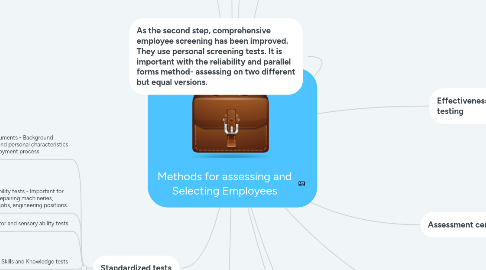
1. As the second step, comprehensive employee screening has been improved. They use personal screening tests. It is important with the reliability and parallel forms method- assessing on two different but equal versions.
2. Reliability and Validity of tests
2.1. Reliability - estimates internal consistency. There are two specific measures in internal consistency.
2.1.1. 1st - Divide the test into two equal parts and correlate the summed score on the first half of the item with the second half of the item. Also called split reliability.
2.1.2. 2nd - Involvement of numerous calculations. It determines the intercorrelation of among all items of the test.
2.2. Validity - The accuracy of inferences or projections we draw from measurements.
2.2.1. Validity Evidence
2.2.1.1. Content Validity - A yield of future performance basis.
2.2.1.2. Construction Validity - Demonstrate relationship between test scores and some measurable criterion of job success.
3. Types of Employee screening
3.1. Most of them are standardized tests. Large organizations use I/O psychologists to create screening tests.
3.2. Tests formats
3.2.1. Individual vs group tests
3.2.2. Speed vs Power tests
3.2.3. Paper and pencil vs Performance tests
4. Standardized tests
4.1. Biodata Instruments - Background information and personal characteristics used in employment process.
4.1.1. Takes great deal of research and validate.
4.1.2. Most likely to be used for higher level positions.
4.1.3. As examples questions involving personal nature, probing the applicant's attitude, values, likes and dislikes.
4.2. Mechanical ability tests - Important for operating or repairing machineries, construction jobs, engineering positions.
4.3. Motor and sensory ability tests
4.4. Job Skills and Knowledge tests
4.4.1. Skills test for Clerical work
4.4.2. Can use work sample of tests. For an example : for a snack bar worker, the test used the cash register, make change, fill out a report, reach to an irate customer.
4.5. Personality tests - designed to measure certain psychological characteristic.
4.5.1. Minnesota Multiphasic Personality Inventory - screened for psychopathology. Used for sensitive jobs such as police officers, airline pilots, nuclear power plant operator. The test has three parts as MMPI - A psychological test questionnaire with 500 different statements, MMPI-2 - Comprises 567 statements answered within 2 hours and finally MMPI-2-RF - consist of 338 statements and a publication of child custody.
4.6. Honesty and Integrity test
4.6.1. Polygraphs - presumed to accompany deception - lie detector.
4.6.2. Integrity tests - measures of honest and dishonest attitudes and or behaviors.
5. Hiring Interviews- it can be a casual conversation, a job interview where the interviewer did all the talking.
5.1. Can ask hypothetical questions.
5.2. Structured behavioral interviews.
5.3. These should have three main objectives. - Interviewer should be able to fill gaps of applicant's resume, provide realistic job previews and it is an important public relation function.
6. Test takers doesn't know which response is correct.
6.1. finally there is evidence that personality and integrity tests are robust.
7. Many tests have subscales designed to find if the tester is lying.
8. Employee screening and assessment
8.1. A process of reviewing information for a job
8.2. Eg : resumes, applications, letter of recommendation, employment tests
9. Evaluation of written materials
9.1. step 1 : Evaluation of written materials. This is a first impression and it plays a big role. Most companies will use standard application form. However it is difficult to come to a conclusion with application form. The organization can quantify information.
9.2. References and letters of recommendation can provide 4 types of information.
9.2.1. Employment and education history.
9.2.2. Evaluation of the applicant's character
9.2.3. Evaluation of the job history
9.2.4. Recommenders' willingness to rehire the applicant.
10. Assessment centers
10.1. Offers a detailed structured evaluation of applicants abilities, knowledge and skills.
10.2. Applicants take part in situational exercises - related to work samples and many. These test can be written, live or presented via video.
10.2.1. A popular situational exercise is the in-basket test - given an overview of the job and asked to prepare agendas, meetings, making decisions.
